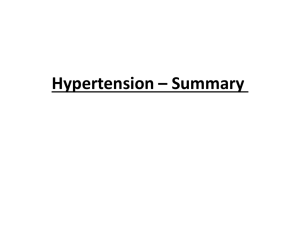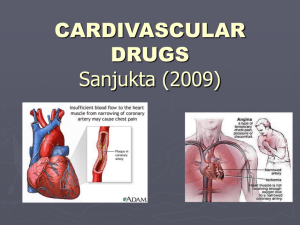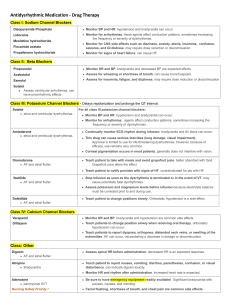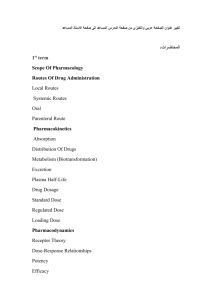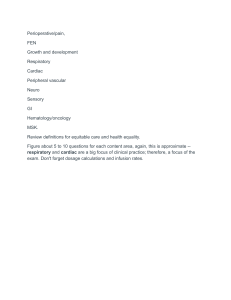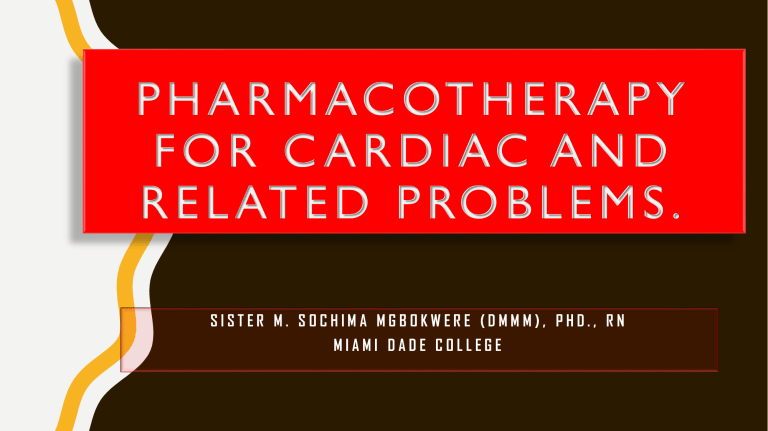
P H A R M AC OT H E R A P Y F O R C A R D I AC A N D R E L AT E D P RO B L E M S . SISTER M. SOCHIMA MGBOKWERE (DMMM), PHD., RN MIAMI DADE COLLEGE LIPOPROTEINS • Lipoprotein is a complex combination of lipids in various amounts along with a protein component called apoprotein to enable transport through the blood. • HDL: Contains the most apoprotein up to 50%. Greater than 60mg/dL is desirable. (Good Cholesterol) • LDL: Contains the highest amount of cholesterol. Less than 100mg/dL is optimal. (Bad Cholesterol) • VLDL: Primary carrier of triglycerides in the blood. Reduced to LDL through a series of steps. TERMS FOR LIPID DISORDERS • Hyperlipidemia • High levels of lipids in the blood • Hypercholesterolemia • Elevated blood cholesterol • Dyslipidemia • Abnormal levels of lipoproteins, excess or deficient LDL & HDL NONPHARMACOLOGIC METHODS FOR CHOLESTEROL REDUCTION Reduce saturated fats in diet. Reduce total fat intake to 30% or less of caloric intake. Reduce cholesterol intake to 300 mg/day or less. Exercise as possible. Stop smoking. Increase in soluble fiber in diet PHARMACOLOGIC APPROACH • TYPES OF ANTILIPIDEMICS 1. HMG-CoA REDUCTASE Inhibitors (STATINS) 2. BILE ACID SEQUESTRANTS 3. NIACIN/NICOTIC ACID(VITAMIN B3) 4. FIBRIC ACID AGENTS 5. CHOLESTEROL ABSORPTION INHIBITORS AND MISCELLENEOUS DRUGS HMG-COA REDUCTASE INHIBITORS (STATINS) • Nursing interventions • Mechanism of Action: Monitor liver enzymes. Interferes with an enzyme HMG-CoA reductase in the synthesis of Report unexplained cholesterol muscle tenderness or • First line drugs for lipid disorder weakness, fever, and treatment malaise. • Slows the progression of CAD • All are contraindicated in pregnancy Teach patient importance • All are given Orally, administer with food to of compliance with health decrease GI discomfort. care regimen. • The primary goal of therapy is to reduce the risk of MI and Stroke. SIDE EFFECTS AND INTERACTIONS HMG-CoA REDUCTASE INHIBITORS (STATINS) ATORVASTATIN (LIPITOR) • SIDE EFFECTS • H/A, Fatigue, Muscle or joint pains • Heartburn, severe myopathy, /Rhabdomyolysis—rare but possible. –Interaction: with SIMVASTATIN (ZOCOR) PRAVASTATIN (PRAVACHOL) ROSUVASTATIN (CRESTOR) Macrolide antibiotics, Azole antifungals, Fibric acid agents, and some immunosuppressants, Grapefruit juice, contraindicated in serious liver disease. BILE ACID SEQUESTRANTS • Bind bile acids to increase the excretion of cholesterol in stool. • Cause more frequent side effects than statins • They are not absorbed into the systemic circulation therefore effects are limited to the GI tract. • Interfere with absorption and minerals • Extended use can cause nutritional deficiency • Can cause bloating, abdominal pain, N/V and constipation – Cholestyramine (Questran), Colesevelam (Welchol), Colestipol (Colestid). NICOTINIC ACID (NIACIN) • It is B-complex vitamin (Vitamin B3) • Much larger doses needed to reduce cholesterol 23gm/day • Rarely used because of side effects • Primary effect is to decrease VLDL levels also reduces triglyceride levels and increase HDL levels • Flushing and hot flashes present in almost all patients • Nausea, excess gas, and diarrhea are common. Hepatotoxicity and gout have been reported. • Will elevate FBS in patients with DM • Rarely used in monotherapy. FIBRIC ACID AGENTS • Used for severe hypertriglyceridemia. • Mechanism of Action: Activates the enzyme lipoprotein lipase which increases the breakdown and elimination of triglycerides from the plasma. • Adverse effects: GI distress, watch for bleeding with patients on anticoagulants • Specific Agents: • Gemfibrozil (Lopid), Fenofibrate (Tricor, Antara). • Administer with meals to reduce GI distress • Pregnancy category B. CHOLESTEROL ABSORPTION INHIBITOR • ezetimibe (Zetia) • Mechanism of action: inhibits absorption of cholesterol in the small intestine. • Primary use: modest reduction in LDL It must be combined with a statin for optimum effect. • Adverse effects: Serious side effects are uncommon. Nasopharyngitis, myalgia, upper respiratory tract infection, anthralgia, and diarrhea are possible adverse effects. • Zetia is pregnancy category C. DIURETICS • KIDNEYS • Primary regulator of fluid and electrolyte balance • Acid base balance • Secrete Renin • Secrete Erythropoietin • Production of calcitriol (active form of Vitamin D) REABSORPTION • Filtrate in Bowman's capsule is same composition as plasma minus large proteins. • Some substances in filtrate cross wall of nephron and reenter blood process called tubular reabsorption. • Most of water in filtrate is reabsorbed. • Glucose, amino acids, sodium, chloride, calcium, and bicarbonate are reabsorbed. SECRETION • Some substances pass from blood through walls of nephron and become part of filtrate. • Potassium, phosphate, hydrogen, ammonium ion, and some acid drugs are secreted into filtrate. • Reabsorption and secretion are critical to pharmacokinetics of many drugs. THE NEPHRON NEPHROTOXIC DRUGS DIURETICS • Diuretics are drugs that alter the volume and/or composition of body fluids. They are given to increase the rate of urine flow • Goal of most diuretic therapy is to reverse abnormal fluid retention in the body. • • • • • INDICATIONS HTN HEART FAILURE LIVER FAILURE AND CIRHOSIS PULMONARY EDEMA DIURETICS • Most common mechanism of action is by blocking the reabsorption of Na+ ion in the nephron. • CLASSIFICATIONS • LOOP DIURETICS • THIAZIDE DIURETICS • POTASSIUM SPARING DIURETICS • CARBONIC ANHYDRASE INHIBITORS • OSMOTIC DIURETICS ADVERSE EFFECTS OF DIURETIC THERAPY • • • • Fluid and electrolyte disturbances Dehydration Orthostatic hypotension Potassium and sodium imbalances LOOP DIURETICS • Blocks the reabsorption of Na+ and Cl- in the loop of Henle. • Na and H20 are lost together with potassium, calcium and magnesium. • THE MOST EFFECTIVE DIURETIC • USED TO REDUCE EDEMA ASSOCIATED WITH HEART FAILURE, PULMONARY EDEMA, LIVER CIRRHOSIS & CRF. • LESS EFFECTIVE AS ANTI HYPERTENSIVE AGENTS. • Highly protein bound, can displace other drugs e.g., warfarin. ADVERSE EFFECTS &CONTRAINDICATIONS MONITOR FOR SIGNS OF DEHYDRATION – THIRST, DRY MOUTH, WEIGHT LOSS, H/A. AND ELECTROLYTES IMBALANCE • Hypokalemia, hyponatremia, hypocalcemia, • hypomagnesemia, hypochloremia • USE CAREFULLY WITH DIGOXIN • USE CAREFULLY WITH OTOTOXIC DRUGS • May diminish hypoglycemic effect of sulfonylureas and insulin. • • • Not used with ANURIC PATIENTS DECREASES THE ELIMINATION OF LITHIUM IF GIVEN CONCURRENTLY WATCH FOR CROSS-SENSITIVITY TO SULFA DRUGS. LOOP DIURETICS FUROSEMIDE (LASIX) BUMETANIDE (BUMEX) TORSEMIDE (DEMADEX) ETHACRYNIC ACID (EDECRIN) THIAZIDE DIURETICS • Blocks Na+ reabsorption in the distal tubule and increase potassium and water excretion. • Less effective than the loop diuretics. • Sometimes raise the blood glucose level. • Contraindicated in preeclampsia or other pregnancy induced hypertension. • Increases the risk of renal toxicity from NSAIDs. • SPECIFIC AGENTS • Chlorothiazide (Diuril) • Hydrochlorothiazide (HCTZ) • Bendroflumethiazide with nadolol (Corzide) • Methyclothiazide (Enduron) • Chlorthalidone (Thalitone) • Indapamide (Lozol) • Metolazone (Zaroxolyn) THIAZIDE AND THIAZIDE-LIKE DIURETICS • Increased potassium loss may occur which enhances the action of digoxin. • Thiazides enhance the action of lithium and lithium toxicity can occur. • Thiazides induce hypercalcemia which enhances the action of digoxin. • Monitor for signs of digitalis toxicity (Bradycardia, N/V, visual changes). • Allergies to sulfa-based medications can indicate hypersensitivity. • Use with caution in pregnant women • Do not administer to lactating women • Use sunscreen to decrease photosensitivity • Take potassium supplements, if ordered • Consume potassium-rich foods(fruits, fruit juices, and vegetables) • Report any tenderness or pain in joints POTASSIUM SPARING DIURETICS • Mechanism of Action: ACTS IN THE LATE DISTAL, AND COLLECTING TUBULE TO PROMOTE NA+ AND H20 EXCRETION AND K+ RETENTION. (blocks the action of aldosterone at the Na+-K+ pump, inhibiting the pump). • Advantage: diuresis without affecting blood potassium levels • Spironolactone may decrease effectiveness of anticoagulants. • Patients taking lithium or digoxin may be at increased risk for toxicity. • Triamterene contraindicated for lactating women • Specific Agents: spironolactone (Aldactone) • Triamterene (Dyrenium), amiloride (Midamor) NURSING IMPLICATIONS • Give with food to improve absorption • Do not give potassium supplements • PREGNANCY CATEGORY D • RISK OF HYPERKALEMIA INCREASED IF TAKEN WITH ACE INHIBITORS – MUSCLE WEAKNESS, FATIGUE, BRADYCARDIA • Can cause gynecomastia, diminished libido • ASA and other salicylates may decrease effects • Acidosis may occur if combined with ammonium chloride • Avoid use of potassium-based salt substitutes • When in direct sunlight, use sunscreen • Do not eat excess amount of foods high in potassium MISCELLANEOUS DIURETICS—CARBONIC ANHYDRASE INHIBITORS • Examples: acetazolamide (Diamox), dichlorphenamide, ethoxzolamide, and methazolamide • Mechanism of action: to inhibit formation of carbonic acid • Primary use: to decrease intraocular pressure(IOP) in patients with open angle glaucoma, used in the management of edema secondary to HF that is refractory to other diuretics. • Adverse effects: Allergic reaction (contain sulfa), fluid and electrolyte imbalances, • Metabolic acidosis, nausea, vomiting, anorexia, confusion, orthostatic hypotension, crystalluria, hemolytic anemia, and renal calculi • Contraindicated in severe renal and hepatic impairment. MISCELLANEOUS DIURETICS—OSMOTIC DIURETICS • Example: mannitol (Osmitrol) • Also used to maintain urine flow in prolonged surgery, acute renal failure, or severe renal hypoperfusion • Mechanism of action: Increase the osmolality (concentration) and Na reabsorption in the proximal tubule and loop of Henle. Monitor for electrolyte imbalance. • Primary use: to reduce intracranial pressure (ICP) due to cerebral edema and to decrease intraocular pressure (IOP) e.g., in glaucoma. Do not use if crystals are present in the vial. Warm to dissolve crystals first or, give immediately after drawing up. CARDIOVASCULAR DISORDER DRUGS REGULATORS OF BLOOD PRESSURE Baroreceptors in the aorta and carotid sinus Vasomotor center in the medulla Hormones: antidiuretic hormone (ADH), atrial natriuretic peptide (ANP), brain natriuretic peptide (BNP) PHYSIOLOGIC RISK FACTORS Excessive intake of saturated fat and simple carbohydrates Alcohol: increases renin secretions GUIDELINES FOR DETERMINING HYPERTENSION Category Systolic Pressure Diastolic Pressure Normal Less than 120 mm Hg Less than 80 mm Hg Prehypertension 120 to 139 mm Hg 80 to 89 mm Hg Stage 1 hypertension 140 to 159 mm Hg 90 to 99 mm Hg Stage 2 hypertension Greater than 160 mm Hg Greater than 100 mm Hg Primary Factors Affecting Blood Pressure RENIN-ANGIOTENSIN-ALDOSTERON SYSTEM A NON PHARMACOLOGIC MANAGEMENT OF HTN THERAPEUTIC/POSITIVE LIFESTYLE CHANGES • • • • • • • • Limit alcohol intake Restrict sodium Reduce intake saturated fat/cholesterol Increase intake of fresh fruits/vegetables Increase physical activity Learn coping strategies Maintain optimum weight Discontinue tobacco use PHARMACOLOGIC MANAGEMENT OF HTN Diuretics Angiotensin-converting enzyme (ace)inhibitors Angiotensin II receptor blockers Calcium channel blockers Beta adrenergic blockers (antagonists) SECONDARY ANTIHYPERTENSIVE AGENTS. Alpha1-adrenergic antagonist Alpha2-adrenergic agonists Direct-acting vasodilators Direct renin inhibitors ACE INHIBITORS AND ACE RECEPTOR BLOCKERS ACE INHIBITORS/RECEPTORS BLOCKERS African-American adults and some older adults Do not respond with ACEI monotherapy Do respond when taken with diuretic Side effects Irritating cough, insomnia, hyperkalemia, tachycardia, angioedema, postural hypotension… • Contraindications Pregnancy Potassium-sparing diuretics such as spironolactone (Aldactone) Salt substitutes that contain potassium ACE INHIBITORS ACE RECEPTOR BLOCKERS DIRECT RENIN INHIBITORS ENALAPRIL (VASOTEC) CANDESARTAN (ATACAND) ALISKIREN (TEKTURNA) BENAZAPRIL (LOTENSIN) LOSARTAN (COZAAR) CAPTOPRIL (CAPOTEN) OLMESARTAN (BENICAR) LISINOPRIL (ZESTRIL) TELMISARTAN (MICARDIS) RAMIPRIL (ALTACE) VALSARTAN (DIOVAN) • CALCIUM CHANNEL BLOCKERS Mechanism of Action: Blocks calcium ions from entering the cell limiting muscle contraction. • Used to treat angina, dysrhythmias, and HTN. • Considerations: • Obtain ECG, heart rate, and B/P prior to therapy During therapy, monitor heart rate and B/P regularly • • • Signs of CHF and reflex tachycardia At low doses, relaxes vascular smooth muscles thereby reducing peripheral vascular resistance • Side Effects: • Dizziness, headache, flushing, hypotension Grapefruit juice may enhance the absorption of CCBs. • • • • • • Works more in the elderly and African American population Specific Agents: AMLODIPINE (NORVASC) NICARDIPINE (CARDENE) NIFEDIPINE (ADALAT, PROCARDIA XL) DILTIAZEM (CARDIZEM) MORE ACTIONS OF CALCIUM CHANNEL BLOCKERS Relax coronary artery spasm (variant angina) Relax peripheral arterioles (stable angina) Decreases cardiac oxygen demand Decrease cardiac contractility (negative inotropic effect that relaxes smooth muscle) Decrease afterload Decrease peripheral resistance Reduce the workload of the heart BETA BLOCKERS • • • • • • • • • Actions/side effects: Decrease HR & contractility Reduce cardiac workload ease symptoms of angina Slows conduction through the myocardium Used in the treatment of migraines, MI, and HF Cardio-selective contraindicated in patients with COPD. Rebound HTN when stopped abruptly… Possible hypoglycemia in patients with DM. May cause male sexual dysfunction( erectile dysfunction, decreased libido) Specific Agents: metoprolol (Lopressor) atenolol (Tenormin) nadolol (Corgard) nebivolol (Bystolic) propranolol (Inderal) • • • ALPHA 1 BLOCKERS Mechanism of Action: Lowers BP directly by blocking sympathetic receptors in arterioles causing vasodilation. Also used in treatment of benign prostatic hypertrophy(BPH). Side Effects: Dizziness, nausea, nervousness and fatigue. • • • • Can cause orthostatic hypotension Can cause Na and H20 retention therefore are prescribed with diuretics ALPHA 2 AGONISTS Inhibit the outflow of sympathetic impulse from CNS to target organs and tissues. Can cause sedation and dizziness, leukopenia, thrombocytopenia, hemolytic anemia, lupus. ALPHA 1 & ALPHA 2 ALPHA 1 BLOCKERS ALPHA 2 AGONISTS (CENTRALLY ACTING) DOXAZOSIN (CARDURA) CLONIDINE (CATAPRESS) PRAZOSIN (MINIPRESS) METHYLDOPA (ALDOMET) TERAZOSIN (HYTRIN) ALPHA 1 & BETA 1 BLOCKERS Labetalol(Normodyne, trandate) DIRECT ACTING VASODILATORS • • • • Mechanism of Action: Cause vasodilation by direct relaxation of arterial smooth muscle Only for severe hypertension and hypertensive crisis Adverse effects: reflex tachycardia, sodium and fluid retention Specific Agents: • Hydralazine (Apresoline), Minoxidil (Loniten), • Sodium nitroprusside (Nitropress, Nipride) • • Treatment of Hypertansive emergency: Sodium Nitroprusside (Nitropress, Nipride) • • • • • • Used for hypertensive crisis, very potent Half-life of 2mins. Must be covered in a dark plastic or foil to avoid decomposition by light during use. Can cause cyanide toxicity. Discard if drug color changes Cannot be used for >24hrs DRUGS FOR HEART FAILURE Inability of ventricles to pump enough blood for body's needs; Weakening of heart muscle due to aging or disease The goals of pharmacotherapy are to remove the underlying cause whenever possible Treat the symptoms of HF, so that the patient’s quality of life can be improved. BRIEF OVERVIEW • CARDIAC OUTPUT PRELOAD CONRACTILITY AFTERLOAD RIGHT AND LEFT SIDED HF POSITIVE AND NEGATIVE INOTROPES (contractility) • • • • • Laboratory tests Atrial natriuretic peptide (ANP) 20 to 77 pg/mL; 20 to 77 ng/L (SI units) Brain natriuretic peptide (BNP)–Desired value: less than 100 pg/mL; positive value: greater than 100 pg/mL Left and right sided Heart failure LEFT SIDED HEART FAILURE • • • • • Blood accumulates in left ventricle Blood backs up into lungs Left ventricle thickens and enlarges: hypertrophy Cardiac remodeling Cough and shortness of breath result RIGHT SIDED HEART FAILURE • • • • Blood accumulates in the right ventricle Blood backs up into jugular veins Causes peripheral edema and organ engorgement Less common than left-sided HF Pathophysiology of heart failure ACC/AHA & NEW YORK HEART ASSOCIATION (NYHA) CLASSIFICATION NYHA ACC/AHA FOUR FUNCTIONAL CLASSES Stages I: Patients with cardiac disease but with no symptoms during physical activity A High risk for HF without symptoms or structural disease B Some levels of cardiac changes (e.g., decrease ejection fraction without symptoms of heart failure) C Structural heart disease with symptoms of HF (e.g., fatigue, SOB, edema, decreased physical activity) D Severe structural heart disease and marked symptoms of HF at rest II: Patients with cardiac disease who have slight limitations on physical activity, with symptoms such as fatigue, palpitations, dyspnea, or angina III: Patients with cardiac disease who have marked limitations during physical activity IV: Patients with cardiac disease who are unable to perform physical activity, and who have symptoms at rest. Characteristics PHARMACOLOGIC MANAGEMENT OF HEART FAILURE Preload, Afterload, Contractility Mechanisms Slowing the heart rate Increasing contractility Reducing myocardial workload PHARMACOLOGIC MANAGEMENT OF HF ACE INHIBITORS Reduce afterload, Drug of choice for heart failure Enhance excretion of sodium and water, Lowers peripheral resistance and reduces blood volume Increases cardiac output ANGIOTENSIN II RECEPTOR BLOCKERS Actions very similar to ACE inhibitors Usually used for patients who are unable to tolerate the adverse effects of ACE inhibitors DIURETICS Increase urine flow, Reduce blood volume and cardiac workload, Reduce edema and pulmonary congestion Prescribed in combination with other drugs BETA ADRENERGIC BLOCKERS Slow heart rate and reduce blood pressure, Inotropic effect Reduce workload of heart DIRECT VASODILATORS Minor role in heart-failure treatment, Lower blood pressure Relax blood vessels, Decrease oxygen demand on the heart CARDIAC GLYCOSIDES Increase cardiac output by increasing the force of myocardial contraction. CARDIAC GLYCOSIDES Digitalis preparations (digoxin) Actions Positive inotropic Negative chronotropic Decreases heart rate Negative dromotropic Increases myocardial contractility Decreases conduction Increase stroke volume Increases cardiac output CARDIAC GLYCOSIDES • • DIGOXIN POSITIVE INOTROPE, NEGATIVE CHRONOTROPE, NEGATIVE DROMOTROPE Improved contractility, Reduced HR, Decrease in Cardiac workload, Increase in CO • *Narrow safety margin • Check pulse one full minute prior to administration must be 60b/m or > • *CHECK DIGOXIN LEVEL PRIOR TO ADMINISRATION therapeutic level usually 0.8-2ng/mL • IMPAIRED RENAL FUNCTION and HYPOKALEMIA INCREASES TOXICITY • • • • • Use carefully with diuretics Contraindicated in AV-Blocks ADVERSE EFFECTS: N/V, fatigue, anorexia, visual disturbances (such as seeing halos, a yellow-green tinge, or blurring, when toxic) Overdose can be fatal Treatment for overdose: • DIGOXIN IMMUNE FAB (DIGIBAND). DRUGS FOR ANGINA PECTORIS AND MYOCARDIAL INFARCTION (MI) ANGINA PECTORIS: Acute chest pain caused by insufficient oxygen to the myocardium Stable : Occurrences are predictable as to intensity, frequency and duration, pain usually subsides with rest. Unstable: Arise more frequently, pain more intense, unpredictable, occurs even at rest Prinzmetal or vasospastic: Unpredictable as a result of spasms of coronary arteries related decreased blood flow. Unrelated to rest or activity, occurs mostly during rest periods. ACUTE CORONARY SYMDROME (ACS) MYOCARDIAL INFARCTION (MI) Complete occlusion of a coronary artery causing death of cardiac muscle. UNSTABLE ANGINA Partial occlusion of the coronary artery by a thrombus causing severe chest acute pain. Goal of pharmacotherapy is to reduce Myocardial O2 Demand by: Slowing heart rate Reducing preload Reducing contractility Reducing afterload) • SELECTED DRUGS Organic Nitrates, Beta Blockers, CCB, Anti-Platelets/ Anticoagulants, Thrombolytics. : • • • • • NITRATES nitroglycerin (Nitrostat) Sublingual, topical (ointment, transdermal patch), buccal extended-release tablet, oral extended-release capsule and tablet, aerosol spray (inhalation), and IV Mechanism of Action: Relaxes both arterial and venous smooth muscle; dilate coronary arteries Reduce myocardial workload, lower myocardial oxygen demand Assist diagnosis of MI: pain that persists 5–10 mins after administration, may indicate MI. Arterial and venous dilation; relieve coronary artery vasospasm NITRATES IV nitrates have greatest risk for severe hypotension • Educate patients that alcohol is contraindicated with nitrates • If hypotension occurs, withhold nitrates SIDE EFFECTS • H/A, postural hypotension, flushing, dizziness, tolerance, rash. CONTRAINDICATIONS: Hypotension, increased intracranial pressure or head trauma, pericardial tamponade, constrictive pericarditis, glaucoma. SPECIAL CONSIDERATIONS: Administer in glass bottle and special nitroglycerin tubing Cover bottle to avoid degradation Use gloves when applying Do not apply over hairy area Change sites when applying topical preparations. Initial, date and time • SHOCK • • • • • Inadequate blood flow to meet body's needs Considered medical emergency Can lead to irreversible organ damage and death Classified by: Underlying pathological condition Organ system causing the disease OVERVIEW OF SHOCK TYPE OF SHOCK DEFINITION UNDERLYING PATHOLOGY ANAPHYLACTIC ACUTE ALLERGIC REACTION Severe reaction to an allergen such as penicillin, nuts, shellfish, or animal proteins CARDIOGENIC FAILURE OF THE HEART TO PUMP SUFFICIENT BLOOD TO THE TISSUES Left heart failure, myocardial ischemia, MI, dysrhythmias, pulmonary embolism, myocardial or pericardial infection HYPOVOLEMIC LOSS OF BLOOD VOLUME Hemorrhage, burns, excessive diuresis, or severe vomiting or diarrhea NEUROGENIC Vasodilation due to overstimulation of the PSNS or under stimulation of the SNS Trauma to the spinal cord or medulla, severe emotional stress or pain, or drugs that depress the CNS SEPTIC Multiple organ dysfunction as a result of pathogenic organisms in the blood, often a precursor to acute respiratory distress syndrome and DIC Wide spread inflammatory response to bacterial, fungal, or parasitic infection. SYMPTOMS OF A PATIENT IN SHOCK PHARMACOLOGIC MANAGEMENT OF SHOCK BLOOD OR BLOOD PRODUCTS To restore volume depending on the clinical situation COLLOIDS- Increase volume by increasing plasma oncotic pressure Albumin Hetastarch (hespan) CRYSTALLOIDS- Used to replace fluid that have been lost and increase urine output NS, Lactated ringers Hpyertonic saline VASOCONSTRICTORS/VASOPRESSORS Used to maintain BP when vasodilation has caused hypotension but fluids have not been lost (e.g. anaphylactic shock) They are considered critical medications, infusions are always via a pump Require continuous monitoring and titration as necessary Discontinuation is gradual Dopamine, Norepinephrine, Neo-synephrine, Epinephrine DOPAMINE is considered both vasopressor and inotropic drug PHARMACOLOGIC MANAGEMENT OF SHOCK INOTROPIC DRUGS • Increase the force of myocardial contraction Used in shock to increase cardiac output • • • • • Medical emergency • Goal of therapy is to prevent further hyper response by body defenses and support the cardiovascular system. • Epinephrine 1:1000 Colloids/Crystalloids Benadryl Bronchodilators (Ventolin) DIGOXIN –Increases myocardial contractility and cardiac output DOBUTAMINE (DOBUTREX) Selective beta 1 used in cardiogenic shock to increase myocardial contractility. GIVEN AS IV INFUSION ONLY DOPAMINE- Both alpha 1 and beta 1 agonist. GIVEN AS IV INFUSION ONLY • Phentolamine (Regitine) administered to area of infiltration if extravasation occurs. ANAPHYLAXIS: • • • DRUGS FOR DYSRHYTHMIAS • Lack of synchronization of the atria and/or ventricles or of the right and left sides of the heart will cause dysrhythmias Dysrhythmias named according to the type of rhythm produced and its location e.g. Atrial or Ventricular fibrillation • DYSRHYTHMIAS ARE ASSOCIATED WITH: HTN, Cardiac Valve Disease, CAD, Medications e.g. Digoxin, Hypokalemia, MI, Stroke, DM, HF. Goals of therapy are to prevent or terminate dysrhythmias in order to reduce the risks and resultant complications • TYPES OF DYSRHYTHMIA • • • • • • Atrial or ventricular tachycardia Atrial flutter Atrial or ventricular fibrillation Heart block Premature atrial or premature ventricular contractions (PVCs) Sinus bradycardia TYPES OF DYSRHYTHMIA Atrial or ventricular tachycardia Atrial flutter Atrial or ventricular fibrillation Heart block Premature atrial or premature ventricular contractions (PVCs) Sinus Bradycardia NON PHARMACOLOGIC THERAPY • • • Catheter ablation—Identify and destroy aberrant cardiac cells that cause dysrhythmias Cardiac pacemaker—Paces heart at set rate Implantable cardioverter defibrillator (ICD)— combination of pacemaker and defibrillator PHARMACOLOGIC MANAGEMENT OF DYSRHYTHMIAS Most antidysrhythmic drugs act by interfering myocardial action potentials by blocking: potassium, sodium or, calcium channels • • Blocking flow through the ion channels (conduction) or Altering autonomic activity (automaticity) Anti dysrhythmics divided into 4 classes CLASS I: SODIUM CHANNEL BLOCKERS CLASS II: BETA ADRENERGIC ANTAGONISTS CLASS III: POTASSIUM CHANNEL BLOCKERS CLASS IV: CALCIUM CHANNEL BLOCKERS Some antidysrhythmics produce their effect by prolonging the refractory period (potassium channel blockers) SODIUM CHANNEL BLOCKERS (CLASS I) :Specific Agent: procainamide (Pronestyl) Mechanism of action: to block sodium ion channels, which slows rate of impulse conduction across heart Primary use: to correct atrial and ventricular dysrhythmias Adverse effects: Creates new dysrhythmias or worsens existing ones, Lupus effect, nausea, vomiting, abdominal pain, headache, high doses can produce CNS effects. procainamide (Pronestyl) 1A, lidocaine 1B, Flecainide 1C BETA-ADRENERGIC BLOCKERS (CLASS II) Specific Agents:: propranolol (Inderal) Acebutolol (Sectral) Esmolol (Brevibloc) Sotalol (Betapace) Mechanism of action: Blocks beta receptors, which reduces automaticity and slows conduction velocity across myocardium Primary use: to treat atrial dysrhythmias associated with heart failure Adverse effects: bradycardia, hypotension with dizziness and fainting, Bronchospasms, hypoglycemia, diminished libido POTASSIUM CHANNEL BLOCKERS (CLASS III) drug: amiodarone (Cordarone) Mechanism of action: Blocks potassium-ion channels in myocardial cells, which prolongs refractory period of the cardiac cycle. Primary use: to treat resistant ventricular tachycardia, atrial dysrhythmias with heart failure Adverse effects: blurred vision, pneumonia-like syndrome, bradycardia, hypotension, Can create new dysrhythmias or worsen existing ones Hypokalemia and Hypomagnesemia should be corrected prior to initiating therapy. Pregnancy category D. CALCIUM CHANNEL BLOCKERS (CLASS IV) Specific Agent: verapamil (Calan) Mechanism of action: to block calcium ion channels, which reduces automaticity and slows myocardial (AV) conduction velocity Primary use: to treat supraventricular dysrhythmias Adverse effects: bradycardia, hypotension, headache Verapamil (calan) Diltiazem (cardizem) ADENOSINE (ADENOCARD) Naturally occurring nucleoside Given as a 1-2 second IV bolus injection Indicated for persistent PSVT Half life is 10 seconds Pay may experience brief period of systole after administration SR. M. SOCHIMA MGBOKWERE (DMMM), PhD., CCRN. MIAMI DADE COLLEGE THROMBOEMBOLIC DISORDERS Conditions in which the body forms undesirable clots THROMBUS A stationary clot. Forms in vessels. Grows in size as more fibrin is added. EMBOLUS A travelling clot. Pieces of a thrombus may break off and travel through the blood stream to affect other vessels. DEEP VEIN THROMBOSIS (DVT) Thrombi in the venous system. Usually forms in the vein of the legs due to sluggish blood flow. THROMBOCYTOPENIA A deficiency in platelets. Occurs when platelet count falls below 150,000mm3. May occur as a result of increased platelet destruction or decreased platelet production. HEMOPHILIAS A, B & von Willebrand’s disease (vWD) Bleeding disorders caused by genetic deficiencies in specific clotting factors. They are typified by prolonged coagulation times. Activated partial thromboplastin time (aPTT) Used to monitor heparin pharmacotherapy Prothrombin time (PT) Used to monitor warfarin therapy Platelet count 25-35 secs; 1.5-2tx higher than the pretreatment value High values indicate risk for bleeding and that heparin dose may need to be reduced INR should be 2-3 to prevent DVT; 2.5-3.5, to prevent arterial thrombosis High values indicate risk for bleeding and that anticoagulant dose may need to be reduced Part of complete blood 150,000-350,000 count Values below 20,000 indicate thrombocytopenia Bleeding time Used for general 2-9mins diagnosis of coagulation disorders Long bleeding count may indicate a low platelet count or anticoagulant therapy Heparin anti-Xa Used to monitor heparin or lowmolecular weight (LMWH) pharmacotherapy in patients with heparin resistance High value indicate a risk for bleeding and that heparin or LMWH dose may need to be reduced 0.3-0.7 international units/mL for heparin; 0.4-1.1international units/mL for LMWH TYPE OF MODIFICATION MECHANISM OF DRUG ACTION DRUG CLASSIFICATION PREVENTION OF CLOT FORMATION Inhibition of specific clotting factors ANTICOAGULANTS Inhibition aggregation of platelet. ANTIPLATELETS Dissolve already formed clots. THROMBOLYTICS REMOVAL OF EXISTING CLOT Inhibition of fibrin destruction HEMOSTATICS PROMOTION OF CLOT FORMATION Administration of missing clotting factors CLOTTING FACTOR CONCENTRATES Mechanism of action: (parenteral) and warfarin (oral) inhibit specific clotting factors to prevent formation or enlargement of clots Primary use: to prevent formation of clots in veins, to treat thromboembolic disorders Specific drugs: heparin Most serious side effect to assess is bleeding. To assess internal bleeding, Monitor CBC, lumbar pain, abdominal bulging, guaiac tests on stool Essential for patient safety to assess coagulation studies • Monitor intake of vitamin K–rich foods; limit intake of garlic. • Monitor for thrombocytopenia • Protamine Sulfate is the antidote • transition from heparin to warfarin. • for heparin overdose. • • Monitor for signs and symptoms Bleeding risk increases during Do not give warfarin to pregnant patients. • Heparin, low–molecular weight of Hepatitis heparin can be given to pregnant Instruct patients not to take ASA, patients. while taking LMWH’s LMWHs Mechanism of action is similar to heparin except inhibition is more specific to Factor X They are administered parenterally Duration of action is 2-4X longer than heparin Less likely than heparin to cause thrombocytopenia Enoxaparin (Lovenox) Dalteparin (Fragmin) Factor Xa Inhibitors Fondaparinux (Arixtra) Rivaroxaban (Xarelto) Direct thrombin inhibitors Mechanism of Action: Bind to the active site of thrombin, preventing the formation of fibrin clots. Argatroban (Argatroban) Dabigatran (Pradaxa) Warfarin (Coumadin) Inhibits the hepatic synthesis of coagulation factors II, VII, IX, and X. Given orally Takes several days to reach maximum therapeutic effect Pregnancy category X Regular monitoring of INR is required Contraindicated in recent trauma, active bleeding, bleeding disorders, severe hypertension, Antidote for overdose is Vitamin K. Mechanism of action: To alter the plasma membrane of platelets so they cannot aggregate. Prolong bleeding time by interfering with aggregation of platelets Primary use: to prevent thrombus formation mostly in the arteries. Prevent MI, strokes, TIA’s. Includes: Aspirin ADP receptor blockers Glycoprotein 11b/111a receptor antagonists Prolonged pressure needed to control bleeding at puncture sites aspirin (ASA) Dipyridamole (Persantine) GLYCOPROTEIN IIB/IIIA Receptors antagonists eptifibatide (Integrillin) tirofiban (Aggrastat) ADP Receptor Blockers Clopidogrel (Plavix) Ticagrelor (Brilinta) Ticlopidine (Ticlid) Discontinue at least 7 days prior to surgery Contraindicated in patients with active bleeding Monitor platelet count and hematocrit Monitor for signs of bleeding if used with other anticoagulants Teach patients about diet ( intake of Vit. K rich food, alcohol) Mechanism of action: Thrombolytics promote the process of fibrinolysis by converting plasminogen to plasmin, which digests fibrin and dissolve clot Used to dissolve life-threatening clots Specific Agents: Alteplase (Activase) commonly called TPA. Reteplase rPA (Retavase) Primary uses To treat acute myocardial infarction, deep vein thrombosis To treat acute ischemic stroke, pulmonary embolism, arterial thrombosis To clear IV catheters Effective if given within 12 hours of onset of symptoms of MI and 3 hours of symptoms of stroke Avoid parenteral injections during therapy Contraindicated in active internal bleeding, history of stroke or head injury within the past 3 months, recent trauma or surgery within 14days, uncontrolled hypertension, arterio-venous malformation Mechanism of action: to prevent fibrin from dissolving (antifibrinolytics) Primary use: Used mostly to prevent and treat excessive bleeding from surgical sites Used to shorten bleeding time. Specific drug: Aminocaproic acid (Amicar) Adverse effects: May cause hyper-coagulation with concurrent use of estrogen and oral contraceptives Monitor for clotting Administer intravenously, monitor site closely Assess for myopathy and myoglobinuria (reddish-brown urine) Teach patient to report symptoms of clotting or bleeding Do not take aspirin Contraindicated in patients with DIC, severe renal impairment TRANSFUSION THERAPY Intravenous administration of whole blood or blood components for therapeutic purposes. • To restore volume • To restore oxygen carrying capacity • To replace clotting factors or platelets to reverse coagulopathy • To replace white blood cells in neutropenic patients ABO SYSTEM Blood type determined by the presence or absence of certain antigens on the surface of red blood cells. Types A, B, AB and O (when neither A or B is present) Hemolytic Blood Reaction Antibodies, (Agglutinins) Foreign Antigens (Agglutinogens) Blood typing and cross-matching prior to Blood transfusion (72 hrs) BLOOD TRANSFUSION Obtain blood component from blood bank following agency protocol Correctly verify product and identify patient with a second person (RN). Clearly identify patient per agency protocol, have patient state first and last name, and date of birth (if able) Verify that component received from blood bank is component ordered by physician Check that the patients blood type and Rh type are compatible with the donor blood type and Rh type. Be sure blood is not discolored or has clots. Check that unit number on unit of blood and on form from blood bank match. Check expiration date and time of unit of blood Record verification process as directed by agency policy TRANSFUSION THERAPY NURSES ROLE • • • • • Review Agency Policy and Procedure regarding BT Verify order and indication for transfusion Assess baseline vital signs, medical history Monitor for signs and symptoms of transfusion reaction Elevation in heart rate, elevation of temperature, pruritis, sob, abdominal pain, N/V CRITICAL POINTS • • • • • NORMAL SALINE is used to prevent coagulation of the blood product. Solutions that contain dextrose will cause coagulation donor blood. A unit of blood should not hang for more than four hours because of the danger of bacterial growth. Do not leave patient for the first 15mins after start of BT (no short cuts) Medication should never be injected into an IV line with a blood component infusing. The transfusion should be stopped immediately and the physician notified if signs of transfusion reaction occur. SIDE EFFECTS • • • • • • Observe for fever with or without chills Observe for tachycardia and /or tachypnea and dyspnea Observe client for hives or skin rash Observe for flushing Observe for GI Symptoms Observe for a fall in blood pressure IN THE EVENT OF TRANSFUSION REACTION • Stop the transfusion • Remove tubing containing blood product and replace it with new tubing, maintain patent IV line using 0.9%NS • Notify physician • Notify blood bank • Obtain blood samples (if needed) from arm opposite transfusion. Check agency policy regarding number and type of tubes to be used • Return remainder of blood to blood bank • Monitor and document vital signs every 15mins or more frequently if needed. • Administer prescribed medications

